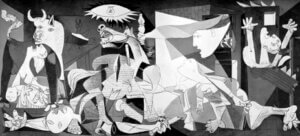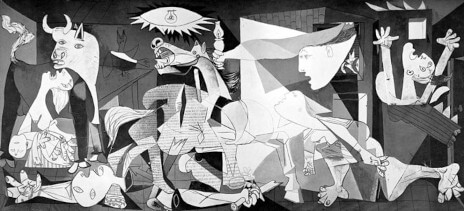
Pablo Picasso’s “Guernica” is not just a painting; it is a profound political statement and one of the most powerful anti-war artworks in history. Created in 1937, this monumental canvas was Picasso’s response to the bombing of the Basque town of Guernica during the Spanish Civil War. Through its stark monochromatic palette, distorted figures, and chaotic composition, “Guernica” communicates a universal message about the tragedies of war and the suffering it inflicts upon individuals, particularly innocent civilians.
Historical Context
On April 26, 1937, the peaceful village of Guernica was bombed by Nazi Germany and Fascist Italian warplanes at the request of the Spanish Nationalists. This unprecedented attack against civilians was intended to support General Francisco Franco’s bid to overthrow the Spanish Republican government. The bombing killed hundreds of civilians and became a chilling prelude to the atrocities of World War II. Shocked by the news, Picasso, who was living in Paris at the time, channeled his outrage and sorrow into his art.
Symbolism in “Guernica”
The Bull and the Horse
Dominant in the painting, the bull and the horse are recurring figures in Picasso’s work, often symbolizing brute force and suffering respectively. In “Guernica,” the bull stands over a woman grieving her dead child, possibly representing the onslaught of Fascism. The horse, in agonizing pain at the center of the painting, might symbolize the people of Guernica. Its suffering is universal, illustrating the brutal impact of war on all facets of life.
The Fallen Warrior
At the bottom left, a warrior lies dead, holding a broken sword and a flower. This might symbolize the fall of the Spanish Republic to the forces of Fascism or a broader message about the futility and destruction of war. The flower suggests a sliver of hope or rebirth amidst the devastation.
The Lightbulb and the Candle
Above the horse’s head, a glaring electric lightbulb resembles an evil eye while a woman holds a candle. These contrasting sources of light could represent the technology of warfare versus human warmth and hope. The lightbulb, akin to the bomb that devastated Guernica, portrays the destructive power of modern military technology.
The Wailing Women
Picasso includes several female figures who express mourning and distress. One woman looks skyward as she cries out in terror, another rushes into the scene holding a dead child. These figures dramatically convey the acute grief and despair caused by war.
Artistic Techniques
Picasso used a cubist style to fragment the scene and disorient the viewer, mirroring the chaos and confusion of the bombing. The monochrome palette strips any sense of a specific time or place, turning Guernica into a timeless symbol of human tragedy and resilience in the face of violence.
Legacy and Relevance
“Guernica” toured globally to raise awareness and funds for Spanish war relief. Today, it hangs in the Museo Reina Sofía in Madrid as a poignant reminder of war’s horror, serving as a universal symbol of tragedy, peace, and hope. The painting’s influence is profound, shaping not only the art world but also how the public perceives and reacts to conflicts.
Conclusion
Through “Guernica,” Picasso communicates a deep, empathetic understanding of suffering and an impassioned plea against the brutality of war. His use of universal symbols within the painting creates a powerful statement on the human condition, pushing the viewer to reflect on the consequences of violence and the hope for peace. In a world still plagued by conflict, “Guernica” remains as relevant today as it was in 1937, continuing to inspire and challenge us to aspire for a world where such atrocities are a distant memory.























